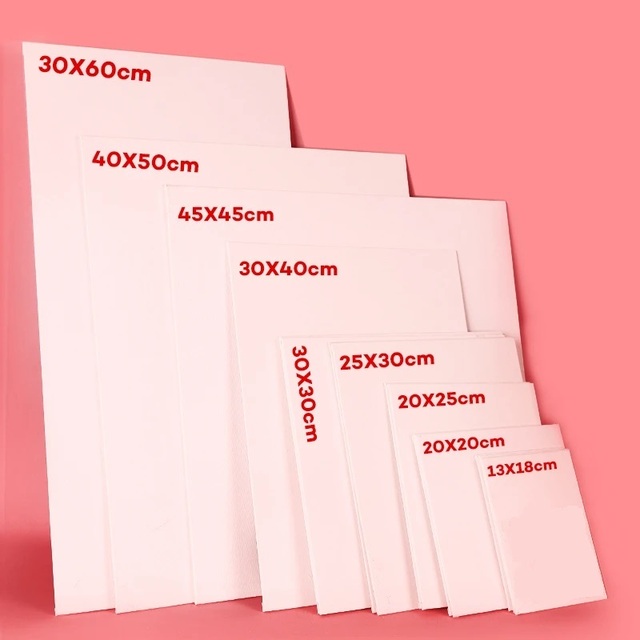
When we think about creating art, we often tend to focus on the medium, the subject, and the techniques used. However, one of the most crucial aspects of creating an artwork is often overlooked: the size of the canvas.
The size of the canvas can have a significant impact on the final artwork, affecting its style, message, and presentation. In this blog post, we will explore the different canvas sizes available and how their selection can impact your artwork.
An Overview of Canvas Sizes
Canvas sizes can vary greatly in both dimensions and proportions, and each size can have a distinct impact on the artwork. Here is an overview of some of the most commonly used canvas sizes:
- Small Canvas Sizes: These can vary from a tiny 4×4 inches to 11×14 inches. Small canvases are typically used for detailed works, sketches, miniatures, and small decorative paintings. They are lightweight, portable, and provide a perfect surface for intricate details with small brush strokes.
- Medium Canvas Sizes: Ranging from 16×20 to 24×36 inches, medium canvases are ideal for larger paintings that require more visual impact. These canvases provide a bigger surface area where the artist has more space to express their creativity.
- Large Canvas Sizes: More prominent than medium canvases, large canvases measure 36×48 inches or larger and are ideal for big statement pieces. Large canvases are perfect for artwork that requires bigger brush strokes and broad, sweeping gestures. They are typically used for large murals, abstract paintings, and landscape paintings.
It’s important to note that these sizes are not set in stone and can vary depending on the artist’s preference and the intended purpose of the artwork.

How Canvas Size Impacts Art Style
When it comes to art style, canvas size can play a significant role. Larger canvases tend to lend themselves to more bold and dramatic strokes, while smaller canvases typically require more detail-oriented work.
For example, take Vincent van Gogh’s “Starry Night.” The intricate details found in this masterpiece, such as the swirling stars and the pastoral town, require a smaller canvas size to capture all the detail. On the other hand, larger canvases may offer the room for more painterly brushwork found in the work of artists like Mark Rothko or Jackson Pollock.
How Canvas Size Impacts Art Message
Canvas size can impact the message that the artwork conveys. Larger canvases tend to create a more immersive experience, inviting the viewer into the world that the artist has created, whereas smaller canvases may create an intimate and personal experience.
For example, the grand and sprawling landscapes found in the Hudson River School movement in the 19th century utilized large canvases to convey the majesty and awe that America’s natural beauty inspired.
How Canvas Size Impacts Art Presentation
Canvas size also has a significant impact on how the artwork is presented to an audience. The size of the canvas can inform the way that viewers experience the artwork, affecting the overall impression of the piece they take away.
For example, if one was to view a small painting in a large room, it may be easily overlooked or lost among the many other objects in the space. Conversely, a large painting in a small room can dominate the space and create a focal point for the viewer’s attention.
Advantages and Disadvantages of Different Canvas Sizes
When it comes to selecting a canvas size for your art piece, it’s important to consider the advantages and disadvantages of different canvas sizes. Below are some pros and cons of various canvas sizes:
Small Canvases (less than 8 x 10 inches)
Advantages:
- Perfect for quick, small sketches or studies
- Easy to store and transport
- Cost less compared to larger canvases
Disadvantages:
- Limited space for detailed work
- May not make an impact as a standalone piece on a large wall or room
Medium Canvases (between 8 x 10 inches to 18 x 24 inches)
Advantages:
- Good size for portraits or still life
- Offers enough space for detailed work
- Can be used as a standalone piece or grouped together for a larger installation
Disadvantages:
- May not work well for larger spaces or rooms
- Transporting larger medium-sized canvases can be an issue
Large Canvases (over 18 x 24 inches)
Advantages:
- Great for large wall spaces or installations
- Offers more creative freedom and space for details
- A statement piece that can showcase the artist’s skills
Disadvantages:
- More expensive than smaller canvases
- Can be difficult to store and transport
- Requires more physical space to work on
In summary, each canvas size offers its own unique advantages and disadvantages. Small canvases are ideal for quick sketches or studies, while medium canvases work well for portraits and still life. Large canvases are perfect for wall installations and creating a statement piece. Ultimately, the choice of canvas size depends on the artist’s vision, budget, and creative needs.
Aspect Ratio and Resolution of Digital Canvases
As digital art becomes more prevalent, it is essential to consider the aspect ratio and resolution of digital canvases. These properties are analogous to the size and shape of traditional canvases.
It’s essential to ensure that the resolution and aspect ratio of your digital canvas match the intended output, whether it’s for printing or digital display.
Choosing the Appropriate Canvas Size
When choosing a canvas size, it is essential to consider every aspect of what you want your final artwork to be. Your chosen size should consider the style, message, presentation, and the technical skill required to execute the artwork.
Of course, there are no hard and fast rules for choosing the appropriate canvas size. This decision is ultimately up to the artist and should be made with careful consideration.
Conclusion
The size of the canvas can have a significant impact on your artwork. It can affect the style, message, and presentation of your piece. Understanding these impacts can help you to choose an appropriate canvas size that can enhance and elevate your art.
What’s your favorite canvas size to work with? Share your thoughts in the comments below or on social media.